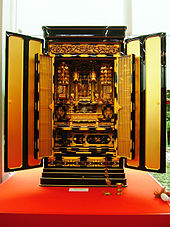Butsudan
A Butsudan ( Japanese 仏 壇 ) is a shrine in a Buddhist temple or monastery, or a Buddhist house altar in Japanese apartments to document the bond with Buddhism and to worship the ancestors and the recently deceased.
When someone dies, the Buddhist priest gives the deceased a new name, which is recorded on an Ihai (an ancestral tablet ) and placed in Butsudan. Offerings are made to the souls of the deceased, e.g. B. rice or tea.
Butsudan is the center of worship at O-Bon , the annual festival of the dead.
The house altar usually consists of a shrine that can be closed with double doors. This can consist of gold-plated carvings, but also of plastic. In addition to a picture or a figure of Buddha , the altar often contains a scroll with calligraphy (for example a Gohonzon in Nichiren Buddhism ), photos, tablets with the names of the deceased and objects that commemorate the deceased.
Today, many Japanese homes do not have a niche for a full-size shrine, or only children inherit a shrine from both paternal and maternal sides. So it is becoming more and more common to get rid of the old shrines. The shrine is dismantled and given to a temple, which burns the shrines together in a ceremony. Small butsudan the size of a shoebox are becoming increasingly popular because they can be placed on a shelf or in a closet.
Shinto house altars in Japan are called Kamidana . The tokonoma , a wall niche for decorations, is also of Buddhist origin.
bibliography
- Buckley, Sandra (2002) "Butsudan and Kamidana" in Buckley, Sandra (Ed.) Encyclopedia of Contemporary Japanese Culture, pp. 56-57. London: Routledge. ISBN 0-415-14344-6 .
- Nelson, John K. (2008). Household Altars in Contemporary Japan ( Memento December 12, 2014 in the Internet Archive ): Rectifying Buddhist “Ancestor Worship” with Home Décor and Consumer Choice, Japanese Journal of Religious Studies 35 (2), 305–330
- Rambelli, Fabio (2010). Home Buddhas: Historical Processes and Modes of Representation of the Sacred in the Japanese Buddhist Family Altar ( Memento of March 22, 2014 in the Internet Archive ), Japanese Religions 35 (1–2), 63–86
Web links
- Website with pictures of Butsudan ( Memento of January 17, 2012 in the Internet Archive )
